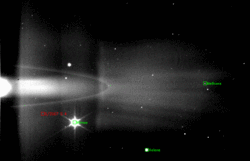Anthe (moon)
 Discovery images of Anthe | |
| Discovery | |
|---|---|
| Discovered by | Cassini Imaging Science Team |
| Discovery date | May 30, 2007 |
| Orbital characteristics[1] | |
| 197,700 km | |
| Eccentricity | 0.001 |
| 1.03650 d | |
| Inclination | 0.1° to Saturn's equator |
| Satellite of | Saturn |
| Physical characteristics | |
| ≈ 1 km | |
| Mass | 5 ×1012 kg[2] |
Mean density | unknown |
| unknown | |
| assumed synchronous | |
| unknown | |
| Albedo | unknown |
Anthe (Template:PronEng AN-thee,[3] or as Greek Άνθη) is a very small natural satellite of Saturn lying between the orbits of Mimas and Enceladus. It is also known as Saturn XLIX; its provisional designation was S/2007 S 4. It is named after one of the Alkyonides; the name means flowery. It is the 60th confirmed moon of Saturn.[4]
It was discovered by the Cassini Imaging Team in images taken on May 30, 2007.[1] Once the discovery was made, a search of older Cassini images revealed this small satellite in observations from as far back as June 2004. It was first announced on July 18, 2007.[1]
Anthe is visibly affected by a perturbing mean longitude resonance with the much larger Mimas. This causes its osculating orbital elements to vary with an amplitude of about 20 km in semi-major axis on a timescale of about 2 Earth years. The close proximity to the orbits of Pallene and Methone suggests that these moons may form a dynamical family.
References
- ^ a b c C. Porco and the Cassini Imaging Team (2007-07-18). "S/ 2007 S 4". International Astronomical Union Circulars. 8857 (subscription required).
- ^ assumed density of 1.2 g/cm³
- ^ This name is too new to appear in dictionaries, but the OED has the analogous rhodanthe /roʊˈdænθiː/.
- ^ Agle, D. C. (2007-07-19). "Saturn Turns 60". JPL (Cassini-Huygens). Retrieved 2007-07-19.
